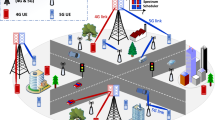Abstract
CSMA/CA based DCF of 802.11 MAC layer employs best effort delivery model, in which all stations compete for channel access with same priority. Heterogeneous conditions result in unfairness among stations and degradation in throughput, therefore, providing different priorities to different applications for required quality of service in heterogeneous networks is challenging task. This paper proposes a collision resolution scheme with a novel concept of introducing offset, which is suitable for heterogeneous networks. Selection of random value by a station for its contention with offset results in reduced probability of collision. Expression for the optimum value of the offset is also derived. Results show that proposed scheme, when applied to heterogeneous networks, has improved throughput and fairness than conventional scheme. Results show that proposed scheme also exhibits higher throughput and fairness with reduced delay in homogeneous networks.









Similar content being viewed by others
Abbreviations
- b k :
-
Mean back-off duration of kth stage for existing scheme
- b mk :
-
Mean back-off duration of kth stage for proposed scheme
- CW :
-
Initial contention window size
- K :
-
Number of back-off stages
- n :
-
Number of stations
- p :
-
Conditional collision probability
- S :
-
System throughput
- T :
-
Packet transmission time
- T c :
-
Time interval, medium is busy due to collision
- T d :
-
Total packet delay
- T s :
-
Time interval, medium is busy for successful transmission
- α :
-
Propagation delay
- σ :
-
Slot time
- τ :
-
Attempt rate
References
R.M. Metcalfe, D.R. Boggs, Ethernet: distributed packet switching for local computer networks. Commun. ACM 19(7), 395–404 (1976)
G. Bianchi, Performance analysis of the IEEE 802.11 distributed co-ordination function. IEEE J. Sel. Areas Commun. 18(3), 535–547 (2000)
A. Kumar, E. Altman, D. Miorandi, M. Goyal, New insights from a fixed point analysis of a single cell IEEE 802.11 WLANs. IEEE Trans. Netw. 15(3), 588–621 (2007)
F. Cali, M. Conti, E. Gregori, Dynamic tuning of IEEE 802.11 protocol to achieve a theoretical limit. IEEE Trans. Netw. 8(6), 785–798 (2000)
Y. Kwon, Y. Fang, H. Latchman, Fast collision resolution MAC algorithm for wireless local area networks. in IEEE Proceedings of Global Communication Conference, pp. 2250–2254 (2002)
Q. Ni, I. Aad, C. Barakat, T. Turletti, Modelling and analysis of slow CW decrease for IEEE 802.11 WLAN. in IEEE Proceedings of Personal Indore and Mobile Radio Communication, pp. 1717–1721 (2003)
Z.H. Hass, J. Deng, On optimizing the back-off interval for random access schemes. IEEE Trans. Commun. 51(12), 2081–2090 (2003)
Q. Zhang, W. Liu, B. Cheng, W. Cheng, Improved IEEE 802.11 MAC performances with collision sequential resolution algorithm. in IEEE Proceedings of Wireless Communication and Networking Conference, pp. 344–349 (2007)
S. Pudasaini, M. Kang, S. Shin, J.A. Copeland, COMIC: intelligent contention control for distributed medium access. IEEE Commun. Lett. 14(7), 656–658 (2010)
R. Upadhyay, S. Tokekar, P.D. Vyavahare, Class of collision resolution schemes with multistep distribution for IEEE 802.11. in IEEE Proceedings of INDICON Conference, pp. 947–951 (2012)
J. Alonso-Zárate, C. Crespo, C. Skianis, L. Alonso, C. Verikoukis, Distributed point coordination function for IEEE 802.11 wireless ad hoc networks. Ad Hoc Netw. 10, 536–551 (2012)
D. Malone, K. Duffy, D. Leith, Modeling the 802.11 distributed co-ordination function in non saturated heterogeneous conditions. IEEE/ACM Trans. Netw. 15(1), 159–171 (2007)
J.-S. Wu, Throughput analysis of IEEE 802.11e EDCA under heterogeneous traffic. Comput. Commun. 32, 935–942 (2009)
K. Kosek-Szott, A comprehensive analysis of IEEE 802.11 DCF heterogeneous traffic sources. Ad Hoc Netw. 16, 165–181 (2014)
R. Upadhyay, P.D. Vyavahare, S. Tokekar, Collision resolution schemes with non overlapped contention slots for heterogeneous and homogeneous WLANs. J. Eng. (2013). doi:10.1155/2013/852959
X. Zhou, J. Caffery Jr., Cross Layer Analysis of IEEE 802.11 DCF in Burst Error Fading Channels with Diversity. Proc. IEEE Wireless Communication, Networking and Mobile Computing. 704-709, (2005)
R. Jain, D.M. Chiu, W. Hawe, A Quantitative Measure of Fairness and Discrimination for Resource Allocation in Shared Computer Systems (DEC Research Report TR-301, Hudson, 1984)
E. Peraria, R. Stacey, Next Generation Wireless LANs, 1st edn. (Cambridge University Press, Cambridge, 2008)
G. Bianchi, L. Fratta, M. Oliveri, Performance evaluation and enhancement of the CSMA/CA MAC protocol for 802.11 wireless LAN. in Proceedings of IEEE Personal Indore and Mobile Radio Communication, pp. 392–396 (1996)
Author information
Authors and Affiliations
Corresponding author
Appendix
Appendix
Homogeneous Network
To evaluate system throughput for homogeneous WLAN using (7) following equations are used.
Heterogeneous Network
If P 1,tr and P 2,tr be the probabilities of only one transmission from class one and class two respectively in heterogeneous network then
The E[U] mean value of useful period and E[NU] mean value of non useful period are evaluated as
where (1 − P tr )is the probability of no transmission from any class and is given by \((1 - P_{tr} ) = (1 - \tau_{1} )^{{n_{1} }} (1 - \tau_{2} )^{{n_{2} }}\)
Rights and permissions
About this article
Cite this article
Upadhyay, R., Vyavahare, P.D. & Tokekar, S. Collision Resolution Scheme with Offset for Improved Performance of Heterogeneous WLAN. J. Inst. Eng. India Ser. B 97, 47–54 (2016). https://doi.org/10.1007/s40031-014-0180-2
Received:
Accepted:
Published:
Issue Date:
DOI: https://doi.org/10.1007/s40031-014-0180-2




